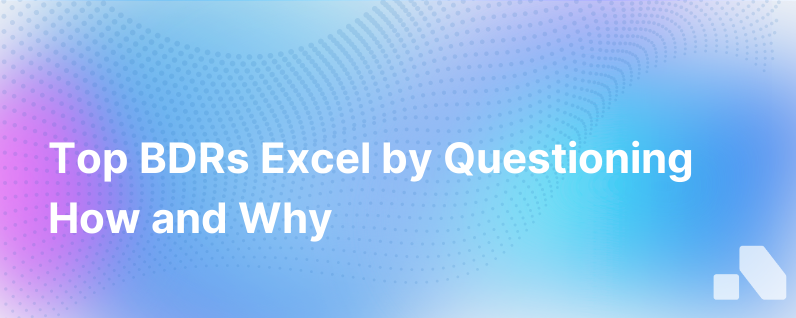
In an ever-competitive B2B landscape, the role of Business Development Representatives (BDRs) is increasingly pivotal. They’re often the first point of contact between a company and its potential clients. Yet in the rush to meet quotas and fill pipelines, it’s easy for BDRs to fall into a transactional rhythm: pitch, handle objections, close. But the best BDRs don’t just pitch—they engage. They understand that the most powerful tools at their disposal are not persuasive talking points, but two simple words: "how" and "why."
In this deep dive, we’ll explore why asking "how" and "why" can be transformative for BDRs, how asking these questions can enrich client interactions, and provide strategies for integrating these questions into everyday conversations with prospects.
The Power of 'How' and 'Why'
The importance of 'how' and 'why' cannot be overstated. They are the bedrock of consultative selling—a method that has revolutionized the way BDRs approach potential buyers. These questions delve into contextual understanding, allowing BDRs to uncover a prospect’s underlying needs, fears, motivations, and goals.
- Asking 'How' lays the groundwork for insight. It enables BDRs to probe into the practicalities of a prospect's business, to understand the reality of their day-to-day challenges. "How do your current processes work?" "How do these challenges impact your goals?" These types of questions help BDRs understand the mechanics behind the needs.
- Asking 'Why' dives deeper into reasoning. It makes prospects think about the purpose and the bigger picture. "Why is this particular challenge important?" "Why have you not found a solution yet?" Such inquiries are valuable as they often reveal the driving force behind a decision, the strategic priorities, and the emotional triggers.
Enriching Client Interactions
The best BDRs use these inquiries to enrich their client interactions. By fostering a dialogue steeped in 'how' and 'why,' they encourage prospects to open up. It's a powerful way to build trust, demonstrating genuine interest and empathy.
Clients are often in the midst of complex, high-stakes decision-making. They yearn for solutions but are bombarded by options. By focusing on 'how' and 'why,' BDRs can cut through the noise and hone in on what really matters to the client. This approach not only positions BDRs as thoughtful problem solvers but also as trusted advisors.
How to Integrate 'How' and 'Why' into Conversations
Integrating 'how' and 'why' into sales conversations requires both practice and intention. Below are strategies that BDRs can use to master this skill:
-
Active Listening: Before asking 'how' or 'why,' a BDR must be an active listener. This means fully concentrating on the speaker, understanding their message, responding thoughtfully, and remembering what is said.
-
Contextual Inquiry: Tailor your 'how' and 'why' questions to the information shared by the prospect. Generic questions yield generic responses; specific questions tailored to the client’s situation reveal valuable insights.
-
Create a Safe Space: Prospects must feel comfortable being candid. Assure them that your goal is to genuinely understand their situation and assist them in finding the best solution, even if it means directing them elsewhere.
-
Be Patient: Expect that some prospects may need to ponder these questions. Give them the time they need, and offer to revisit these topics at a later stage.
-
Use Open-Ended Questions: Open-ended questions cannot be answered with a simple "yes" or "no" — they require more thought and discussion, which is the essence of these types of questions.
Questions That Lead to Discovery
Exploring functional needs, strategic initiatives, and personal wins can make the difference between a disengaged prospect and a future champion for your solution. Here are examples of 'how' and 'why' questions BDRs might use:
-
Functional Discovery:
- How are your current systems inhibiting your performance?
- Why is this the right time to consider a new solution?
-
Strategic Discovery:
- How does your current strategy align with your long-term vision?
- Why are certain goals prioritized over others in your organization?
-
Personal Discovery:
- How would solving this challenge impact your role directly?
- Why do you think previous solutions haven’t provided the results you're seeking?
The Art of Calibration
Knowing when to ask 'how' and 'why' is as important as the questions themselves. This requires calibration, which comes with experience and awareness.
Initially, BDRs might face resistance; not every prospect responds well to what can feel like an interrogation. It’s important, therefore, to infuse these questions within a friendly, conversational framework. The timing of the questions should feel natural, and the tone inquisitive but not invasive.
Conclusion
The quintessential BDR is a detective of sorts, delving into the complex tapestry of client needs, wants, and challenges. They don't settle for surface-level understanding; they dig deeper to provide value.
Inculcating the habit of asking 'how' and 'why' can transform a BDR from an average pitcher of products to a conductor of meaningful business conversations. It's about shifting from transactional to transformational interactions, which can markedly enhance the efficacy of their efforts.
Remembering to ask 'how' and 'why' lays the foundation for not just understanding business needs but also for building lasting relationships based on trust, relevance, and insight—characteristics that define the most successful BDRs.